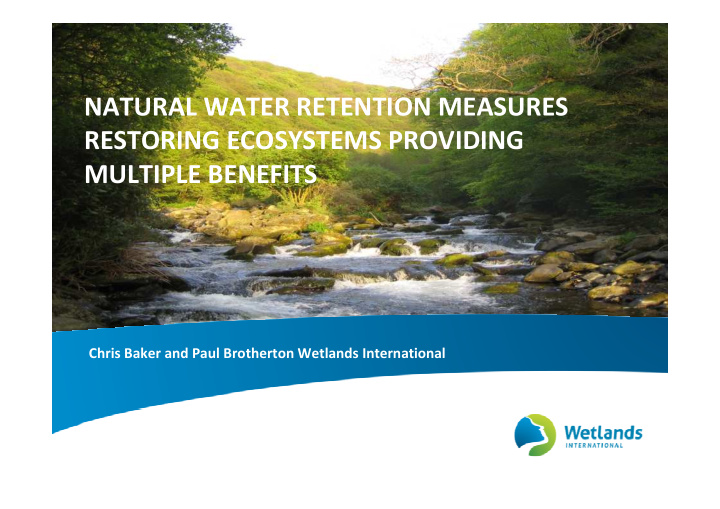



NATURAL WATER RETENTION MEASURES RESTORING ECOSYSTEMS PROVIDING MULTIPLE BENEFITS Chris Baker and Paul Brotherton Wetlands International
Session aims • Raise awareness of Natural Water Retention Measures (NWRM) amongst the river restoration community • Explore the opportunities that NWRM provides for river restoration • Discuss and identify the pre-conditions to deliver NWRM
SESSION 02 NATURAL WATER RETENTION MEASURES RESTORING ECOSYSTEMS PROVIDING MULTIPLE BENEFITS ORAL PRESENTATIONS • Natural Water Retention Measures explained, Chris Baker, Wetlands International [10 minutes] Questions and clarifications [5 minutes] • Brief introduction to facilitated breakout groups. Pierre Strosser (ACTeon) [5 minutes] • Good enough? Evidence on multiple benefits of NWRM from EU’s NRWM Pilot Project. Gonzalo Delacámara, IMDEA [10 minutes] Questions and clarifications [5 minutes] • Natural retention as a part of integrated water resources management - experience from Central and East Europe. Tomasz Okruszko, Warsaw University of Life Sciences [15 minutes] Questions and clarifications [5 minutes] • NWRM in Spain: successes and challenges for future implementation. Josu Elso, Iberian Centre for River restoration [15 minutes] Questions and clarifications [5 minutes] • Ready to go? Preconditions to implementing NWRM. Pierre Strosser, ACTeon [10 minutes] 16: 30 – 17:00 Coffee Break BREAKOUT DISCUSSION • Round table discussion groups to discuss NWRMs [55 minutes discussion, including short report back from group work] • Closing remarks, summary by the Chair [5 minutes]
EU Policy Blueprint to Safeguard Europe’s Waters • 2012 review to improve implementation of current water legislation • integration of water policy objectives into other policies • fill the gaps in relation to water quantity and efficiency • • River restoration & green infrastructure directly support aims of WFD, but guidance not enough to stimulate action - no obligation • Blueprint highlights the benefits of green infrastructure as a solution to water-related challenges of land use, reduction of flood & drought risk 4
Natural Water Retention Measures Explained Definition Natural Water Retention Measures are multi-functional measures that aim to protect water resources and address water-related challenges by restoring or maintaining ecosystems as well as natural features and characteristics of water bodies using natural means and processes. The main focus of applying NWRM is to enhance the retention capacity of aquifers, soil, and aquatic and water dependent ecosystems with a view to improve their status. Appropriate application of NWRM supports green infrastructure, improves the quantitative status of water bodies as such, and reduces the vulnerability to floods and droughts. It positively affects the chemical and ecological status of water bodies by restoring natural functioning of ecosystems and the services they provide. The restored ecosystems contribute both to climate change adaptation and mitigation. 5
Natural Water Retention Measures What are they? Type Class Non-exhaustive list of examples Restoration and maintenance of rivers, lakes, aquifers and Direct modification Hydro-morphology (Rivers, Lakes, Aquifers, connected connected wetlands; Reconnection and restoration of in ecosystems wetlands) floodplains and disconnected meanders, elimination of riverbank protection… Restoration and maintenance of meadows, pastures, buffer strips and shelter belts; Soil conservation practices (crop Agriculture rotation, intercropping, conservation tillage...), green cover, mulching… Change & adaptation in land- Afforestation of upstream catchments; targeted planting use & water for "catching" precipitation; Continuous cover forestry; Forestry and Pastures management maintenance of riparian buffers; urban forests; Land-use practice conversion for water quality improvements… Green roofs, rainwater harvesting, permeable paving, swales, soakaways, infiltration trenches, rain gardens, Urban development detention basins, retention ponds, urban channel restoration… 6
Promotion of uptake and implmentation • Guidance To maximise the use of Natural Water Retention • Measures (Green Infrastructure) CIS Guidance by 2014 • Financing Structural & Cohesion Funds • European Investment Bank loans to support Natural • Water Retention Measures. • NWRM pilot initiative
EU level guidance Short policy document (for policy and decision-makers, 15 -20 pages ) • Aim: • Explain policy relevance of NWRM, stimulate uptake Target Group: • - Water Directors and decision-makers at the National Competent Authorities for WF/FD - persuade other policy makers for joined action - Local and regional catchment-scale decision-makers. Guidance document to be reviewed and approved by WFD Common • Implementation Strategy Steering Committee Group & Water Directors in Nov-Dec 2014 WG Programme of Measures Drafting team - DG ENV, DE, FR, IT, NL, UK, • EEB, WWF, WI, NWRM PP and WFD CIS support consultants 8
Natural Water Retention Measures Pilot Project Main deliverables knowledge base on NWRM that can easily be accessed by all within • the Water Information System for Europe (WISE); - Case studies and experiences - Technical background and practical guidance tools Development of an active European “community of NWRM • practitioners” , Website: http://nwrm.eu/ • Guidance document for policy makers approved by SCG & Water • Directors in Nov-Dec 2014 How to Implement from here, what are the obstacles and opportunities? 9
Enjoy the session! Chris Baker: chris.baker@wetlands.org Paul Brotherton: paul.brotherton@wetlands.org
Recommend
More recommend